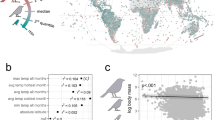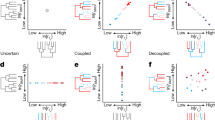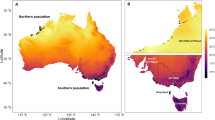Abstract
The basal rate of metabolism of birds and mammals is the lowest rate that is compatible with endothermic temperature regulation, balancing the heat generated with the heat lost by the product of thermal conductance and the temperature differential with the environment1. Here I measure the bioenergetics of 13 species and 9 genera of birds of paradise (Paradisaeidae) and show that 99% of the variation in their basal rates of metabolism can be accounted for by interspecific variation in body mass, food habits and altitudinal distribution. These findings, which are derived from 31% of the species and 53% of the genera in this family, give the most complete picture of the standard energetics of any diverse family of birds.
This is a preview of subscription content, access via your institution
Access options
Subscribe to this journal
Receive 51 print issues and online access
$199.00 per year
only $3.90 per issue
Buy this article
- Purchase on Springer Link
- Instant access to full article PDF
Prices may be subject to local taxes which are calculated during checkout

Similar content being viewed by others
References
McNab, B. K. The Physiological Ecology of Vertebrates: A View from Energetics (Cornell Univ. Press, Ithaca, New York, 2002).
McNab, B. K. Am. Nat. 116, 106–124 (1980).
Glazier, D. S. Comp. Biochem. Physiol. 80A, 587–590 (1985).
Nagy, K. A. Ecol. Monogr. 57, 111–128 (1987).
Nagy, K. A. Aust. J. Zool. 42, 43–53 (1994).
Koteja, P. Funct. Ecol. 5, 56–64 (1991).
Ricklefs, R. E., Konarzewski, M. & Daan, S. Am. Nat. 147, 1047–1071 (1996).
Frith, C. B. & Beehler, B. M. The Birds of Paradise (Oxford Univ. Press, Oxford, 1998).
Bartholomew, G. A., Vleck, C. M. & Bucher, T. L. Physiol. Zool. 56, 370–379 (1983).
McNab, B. K. Comp. Biochem. Physiol. 127A, 309–329 (2000).
McNab, B. K. Auk 118, 916–933 (2001).
Reynolds, P. S. & Lee, R. M. Am. Nat. 147, 735–759 (1996).
Beehler, B. M. in Acta XIX Congr. Internat. Ornithol. (ed. Ouelett, H.) 816–828 (Ottawa Univ. Press, Ottawa, 1989).
Author information
Authors and Affiliations
Ethics declarations
Competing interests
The author declares no competing financial interests.
Rights and permissions
About this article
Cite this article
McNab, B. Ecology shapes bird bioenergetics. Nature 426, 620–621 (2003). https://doi.org/10.1038/426620b
Issue Date:
DOI: https://doi.org/10.1038/426620b
This article is cited by
-
Behavioral and ecological factors account for variation in the mass-independent energy expenditures of endotherms
Journal of Comparative Physiology B (2015)
-
Physiological responses in rufous-collared sparrows to thermal acclimation and seasonal acclimatization
Journal of Comparative Physiology B (2009)
-
Phenotypic flexibility in basal metabolic rate and the changing view of avian physiological diversity: a review
Journal of Comparative Physiology B (2008)
-
Food habits and the evolution of energetics in birds of paradise (Paradisaeidae)
Journal of Comparative Physiology B (2005)
Comments
By submitting a comment you agree to abide by our Terms and Community Guidelines. If you find something abusive or that does not comply with our terms or guidelines please flag it as inappropriate.



